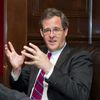I have just witnessed the future of public education in America and I am so excited that my head is brimming with optimism.
It is housed in a very old-fashioned public school, PS 398, in one of the most disadvantaged neighborhoods in New York, Crown Heights in Brooklyn.
The New American Academy, led by its dynamic and enlightened leader, Shimon Waronker, is a paradigm shift in public education that must be seen to be believed. Its principles are so radical, yet so simple, that every day we do not try to replicate it is a crime against our generation's young children.
At The New American Academy -- which I was told to go see by the United Federation of Teachers President Michael Mulgrew -- Waronker, a protege of former Chancellor Joel Klein (when was the last time Mulgrew and Klein agreed on anything?) teachers and students come first. Bureaucracy, administrators, substitute teachers and other wasteful spending have been cut out of the equation.
The New American Academy has two radical approaches to early childhood education -- teaching teams and the open classroom. Neither are new ideas, but when integrated together, and guided by a skilled and visionary educator like Waronker, it can work magically.
Let me explain. At TNAA, prospective teachers go through an incredibly rigorous and inclusive hiring process, which includes on-the-spot written essays, collaborative sessions with other teachers and classroom instruction sessions that are evaluated by potential future peers.
For those lucky enough to pass this daunting gauntlet, some are hired as "Apprentice Teachers" for two years at approximately $50,000 per year, five percent more than a typical starting teacher makes in New York City Schools. On average, TNAA teachers make 38% more than other public school teachers in New York.
These applicants become part of a four-teacher team that instructs 60 students (an incredible 15:1 ratio, comparable to private schools). The team is led by a "Master Teacher," a highly skilled and experienced teacher who is paid $120,000 per year, 20 percent more than the pay ceiling for NYC school teachers.
The "Master Teacher" I watched that day kept 30 seven-year-olds spellbound and engaged while she taught them spelling and grammar and punctuation on a smart board. Twenty hands shot up each time she asked who spotted the next error, and when a child spoke inaudibly or in incomplete sentences, she gently instructed that child to speak up or to rephrase their answer more thoroughly.
The "Master Teacher" was fully in control of this large group, while her other team teachers worked in small reading groups with kids of comparable abilities. It was a scene so perfect in its execution that it actually gave me hope for the first time in a while that we can make real strides in elementary school education.
The Headmaster (not Principal) is the "head of the master teachers," an important distinction from other models. Shimon Waronker is an educator who takes his greatest pride in mentoring his "Master Teachers" who then mentor their "Apprentice Teachers" and "Associate Teachers" and "Partner Teachers" (the latter two being the tiers instructors move up to when they gain a certain proficiency).
The open classroom is an even harder concept to describe, but here goes: in this model, there are 60 students and four teachers in a large open space that allows for different groups to be taught by different teachers. So, no isolation of teachers and kids from each other in discrete classrooms. This allows for more fluidity between lessons and teachers and allows the "Master Teacher" to either teach a group or to float between other groups and observe and mentor the other teachers on the team.
Children can be grouped according to ability for certain lessons and receive extra attention from the teacher who has an expertise in that subject area. If one of the four teachers is absent, like one was in the group I witnessed, there is no need for a costly and ineffectual substitute. The team of three just picks up the slack and everyone benefits.
New teachers at The New American Academy also benefit from a 5-week rigorous training program before they start, with one of those weeks being at the venerated Harvard education program. This is one of the key components missing in our current education system -- proper teacher training -- before and during teachers tenures. TNAA has a sound approach to this that also should be closely watched for replication.
There are a number of other innovative ideas I witnessed there: kids are fed and given time to exercise between 8:30-9:30 am in the morning (in two shifts) while teachers meet with their teams for 90 minutes (8-9:30 am) to prepare their plans for the day and review what went right or wrong in previous days. This "reflection" is part of the ethos of the school.
And the kids start their day well fed, something that is overlooked at so many other Title 1 schools in the city, where breakfasts are served before school starts and many kids do not make it in time to consume the most important meal of the day.
Like John Dewey, an education visionary from the early 20th century, Shimon Waronker (and his colleagues Yehudi Meshchaninov and Nick Ackerman) is lighting the way to a better educational future. New York Times columnist David Brooks has already highlighted Waronker's work in one of his columns.
Now, how do we get the New York Department of Education and the Governor's office in Albany (who recently put together a blue-ribbon panel commission that incorrectly did not include Waronker) to go to Crown Heights, Brooklyn, like I did this week and witness this education miracle?
Our kids can't wait.
Tom Allon, a former English teacher at Stuyvesant High School, is a 2013 Liberal and Democratic candidate for Mayor of New York City.
Follow Tom's campaign on Twitter: @TomAllon4Mayor
And join him on Facebook.
